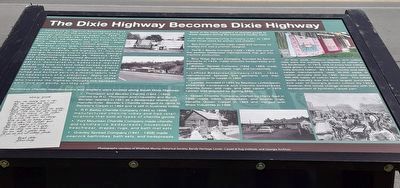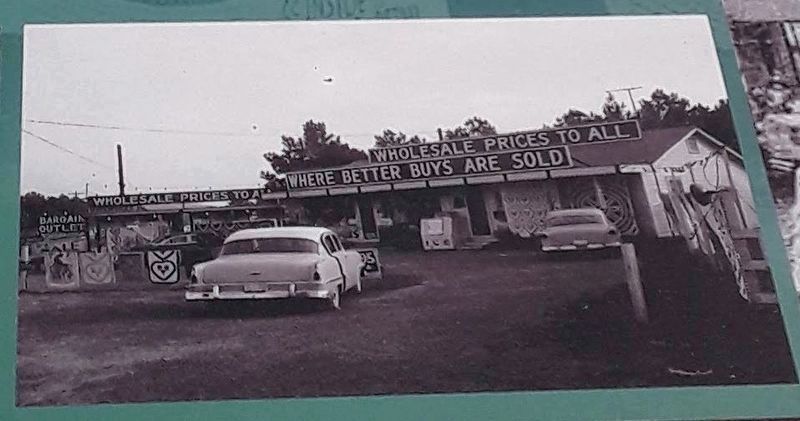Dalton in Whitfield County, Georgia — The American South (South Atlantic)
The Dixie Highway Becomes Dixie Highway
Conceived by regional businessmen in 1915, construction for the portion of US Highway 41 through Whitfield County began in 1926 and opened on October 29, 1929 with much fanfare. Before I-75, U S Highway 41, also known as the Dixie Highway, was one of the major north-south routes in the United States.
Because of the large number of bedspreads for sale hanging from clothes lines located along the roadside, US Highway 41, from the Georgia-Tennessee line to Cartersville, Georgia was affectionately known as "Peacock Alley" and sometimes, "Bedspread Boulevard." From the 1930s to the 1950s, the pea cock bedspread pattern dominated the bedspread market and at one time outsold other spread patterns tenfold. The items were chenille, the French word for caterpillar, so named because the tufted and fluffed yarn in a muslin fabric has the appearance of a caterpillar. Many of the individuals who made bedspreads and those who traveled the highway thought the spreads were loud and gaudy, but they sold.
Numerous chenille manufacturers and retailers were located along South Dixie Highway:
• Thomason and Beckler Chenille (1944-1950) owned by R.C. Thomason and Claudette and Burch Beckler, opened in 1951 as a bedspread retailer and manufacturer. Beckler's Chenille changed its name to Beckler's Carpet in 1964 and is still in business today.
• R.P. Bailey Chenille Company (1945 to 1958) manufactured chenille robes and had retail locations that sold all types of chenille goods.
• Fort Mountain Chenille Company made chenille and candlewick bedspreads, housecoats, beachwear, drapes, rugs, and bath mat sets.
• Gravley Spread Company (1941-1958) made peacock bathrobes, bath sets, and bedspreads.
Some of the many suppliers of chenille goods to these retailers during the industry's heyday were:
• Art-Rich Manufacturing Company (1947 to 1983) made house robes for women and children.
• Ben Putnam Chenille made robes and spreads for retailers and was a premier designer.
• The B.J. Bandy Company (1929-1953) was one of the earliest bedspread manufacturers that got into machine production.
• Blue Ridge Spread Company, founded by Samuel Hurowitz in 1933, made chenille bedspreads and garments.
• Brooker Spread Company (1932-1983) made beach capes, bedspreads, rugs, and housecoats.
• LaRose Bedspread Company (1935-1954) manufactured spreads and garments and then changed over to carpet in 1954.
• Lawtex, founded in 1935 by Seymour Lorberbaum, produced candlewick and chenille bedspreads, chenille robes, and rugs, and later carpet. In 1979, Lawtex was acquired by Spring Mills.
• Queen Chenille Company, started by Harry Saul in 1946, made robes, bedspreads, and scatter rugs, became Queen Carpet in 1969 and merged with Shaw Industries in 1998.
At their peak, Dalton's chenille and cotton mills were the leading consumers of cotton in the Southeast. In 1916, one of every four cotton bales grown in the United States was used in the mills around Dalton. By 1946, chenille and early carpet manufacturers used 30,000 bales of cotton annually and by 1950, devoured 500,000 bales of cotton each year. The tufted textile industry was the third largest purchaser and user of Georgia grown cotton by 1952; however, this would change drastically with the development of synthetic carpet yarn.
Photographs courtesy of Whitfield-Murray Historical Society, Bandy Heritage Center, Carpet & Rug Institute, and Georgia Archives
Erected 2021 by The Center for Public History of the University of West Georgia’s Department of History. (Marker Number #8.)
Topics. This historical marker is listed in these topic lists: Agriculture • Industry & Commerce • Roads & Vehicles. A significant historical date for this entry is October 29, 1929.
Location. 34° 40.795′ N, 84° 59.141′ W. Marker is in Dalton, Georgia, in Whitfield County. Marker is at the intersection of South Dixie
Road (U.S. 41) and Rawlings Way, on the right when traveling south on South Dixie Road. Touch for map. Marker is at or near this postal address: 3818 S Dixie Rd, Dalton GA 30721, United States of America. Touch for directions.
Other nearby markers. At least 8 other markers are within 5 miles of this marker, measured as the crow flies. Battles of Tilton (approx. 1.7 miles away); The Chase, and a Battle (approx. 2.9 miles away); Ascent to Dug Gap (approx. 4.2 miles away); Snake Creek Gap (approx. 4.4 miles away); Battle of Resaca (approx. 4.4 miles away); a different marker also named Battle of Resaca (approx. 4.4 miles away); Dug Gap (approx. 4.6 miles away); Battle of Dug Gap (approx. 4.6 miles away). Touch for a list and map of all markers in Dalton.
Also see . . .
1. Bandy Heritage Center.
"Welcome to the Bandy Heritage Center!(Submitted on April 22, 2021, by David Tibbs of Resaca, Georgia.)
As a community outreach program of Dalton State College, the Bandy Heritage Center celebrates the history and culture of Northwest Georgia. This mission is achieved through collaboration with partnering historical and cultural organizations throughout the area, enabling the Center to fulfill its role as the primary source for information related to the region's historic resources."
2. The Carpet and Rug Institute, Inc.
"If You Can Measure It, You Can Improve It CRI’s Seal of Approval(Submitted on April 22, 2021, by David Tibbs of Resaca, Georgia.)
(SOA) program is all about cleaning efficacy and constant improvement. We wanted to know how well vacuums, extractors, and cleaning solutions worked to clean carpet, so we developed the carpet industry’s only scientific program to test and measure the effectiveness of cleaning products and equipment. The program helps consumers make informed decisions and manufacturers improve their products. The results are cleaner, healthier, and longer-lasting carpet."
3. Downtown Dalton Visitor Center & Historic Freight Depot.
"The Dalton Freight Depot is home to the Bandy Heritage Center, a display of historical collections from Northwest Georgia. Currently, history of the textile industry in Dalton is on display."(Submitted on April 22, 2021, by David Tibbs of Resaca, Georgia.)
Credits. This page was last revised on December 2, 2022. It was originally submitted on April 22, 2021, by David Tibbs of Resaca, Georgia. This page has been viewed 342 times since then and 50 times this year. Photos: 1, 2, 3. submitted on April 22, 2021, by David Tibbs of Resaca, Georgia. • Bernard Fisher was the editor who published this page.


